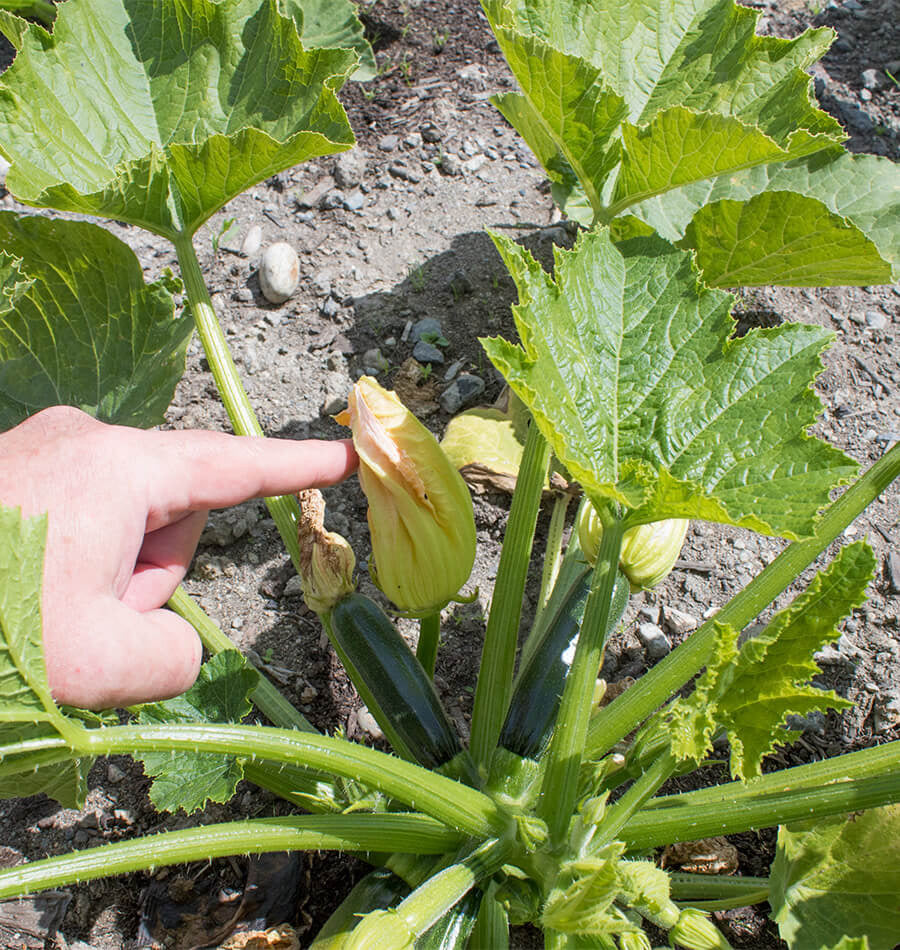Every year from late June to July we start hearing from would-be squash growers with a mysterious complaint: The plants appear healthy, the leaves are bright green, plenty of flowers are opening, but the fruits seem to wither from the blossom end. Instead of producing nice, plump fruits, they turn from green to pale yellow. Some just fall off the plants. This is the result of incomplete squash pollination.
Let’s look at how squash pollination works.

Male squash blossoms, borne on long, narrow stems

Female squash blossoms – at the base is the ovary, which will become the fruit when fertilized
Squash biology is actually pretty cool stuff. All squash (including acorns, pumpkins, zucchinis, spaghetti, etc…) are monoecious. This means that each plant bears male flowers that produce pollen, as well as female flowers that receive pollen. Both types of flower produce nectar, so they are both attractive to bees. In the right setting, many male flowers are open, and visiting bees are getting covered in pollen as they search for nectar. At the same time, many female flowers are open, and that pollen is being transferred by the bees.
Two issues make this scenario more complicated. First, the squash plant produces many flowers, both male and female, sequentially, not all at once. Second, it takes as many as twelve visits from a pollen-laden bee to completely fertilize the female flower. Think about this for a moment. It’s within the realm of possibility that a single bee may transfer just the right amount (and type) of pollen grains to the perfect spot in the female flower on the first visit. But on average, many more visits are required to accomplish pollination.
So understanding flower formation in squash plants is helpful. I looked around on the farm for squash flowers to help illustrate this complicated business, and here are some that I found.

This pumpkin has lots of flower buds. One is open, one is faded, and at least five more are coming. But they are all male. No female flowers are visible in the picture. Maybe the plant is training local bees to check regularly for nectar?

This zucchini shows the sequential nature of blossoming. Some flowers are faded, and some are coming. Only one (female) flower is in bloom. For the plant, each flower is a roll of the dice. If pollination does not occur, the plant moves on to the next flower.

This zucchini has a male flower that has closed. it was probably open yesterday.

Here is a female pumpkin blossom that closed yesterday. Was it fertilized? Too early to tell.

On this pumpkin, one female blossom has closed and another will open shortly. Early signs look like the closed blossom might not have been pollinated, as the blossom end is beginning to turn yellow.
On some squash plants, particularly summer squash like zucchinis, a fruit that was not pollinated completely will be obvious. I have seen them plump at the base, but withered and dried up at the blossom end. These failed fruits are aborted by the plant so that no more energy is wasted on them. Once you are sure that a fruit has failed, use a clean, sharp instrument to cut it from the plant. Left on the plant, they will eventually rot, and can cause problems.
Solutions
This whole conversation illustrates the importance of bees in our landscape. It is their diligent work that spreads all of the pollen back and forth. Without bees, many crops would simply fail to produce. The first strategy for the squash grower is to encourage more bees. This is accomplished by planting lots of flowers nearby. Sunflowers planted in the squash bed act like a beacon because they are visible from hundreds of meters away. Other plants bloom in such profusion that no pollinator would pass without a closer look. These include, but are not limited to:
Alyssum
Calendula
Crimson Clover
Nemophila
Phacelia
Sunflowers
White Dutch Clover
In any case, look for annuals with abundant flowers that will be in bloom at the same time as the squash plants. In all cases, when the biodiversity of flowers increases, pollination is improved. Growers need to think of the flowers above as gardening tools — just another aspect of growing a healthy crop.
Where bees are scant, or in settings like balconies that cannot accommodate flowers to attract bees, hand pollination is another option. The principle is fairly straight forward: Pollen is transferred from the open male flower to the stigma of the open female flower. At this point, the male flower can even be removed and dissected, as it is not going to be feeding any bees or serving the plant. A tool like a fine paint brush can be used to transfer the pollen, or the parts of the two flowers can be brought into contact in order to fertilize the female ovary.
Hand pollination can be a precise and accurate procedure — there are propagation experts out there who can hand pollinate the fussiest flowers. But in the typical garden setting it is not a sure fire practice. It may work well on some, but not all, flowers.

What’s missing from this squash row? It would be well served by interplanting with sunflowers or Alyssum.
















